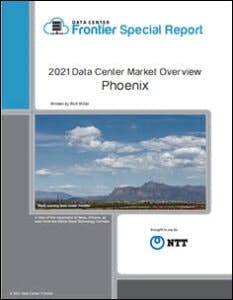Last week in our special report series on the Phoenix data center market, we looked at how major data center players are expanding to the Phoenix suburbs of Goodyear and Mesa. This week, we’ll take a deeper look at the business environment that’s helping Phoenix to become a destination for providers from other markets—particularly California—who are seeking to place data center assets in a location with low disaster risk, either for primary or backup data centers.
Download the full report.
ECONOMIC DEVELOPMENT AND INCENTIVES
n a boost for the data center market in Phoenix, Gov. Doug Ducey has signed legislation that reauthorizes and strengthens Arizona’s tax incentive package for data centers, extending tax breaks through 2033. The update to the incentives provides extended visibility into the cost of operating data centers in the state, which is crucial factor for companies considering Phoenix versus other markets in a site selection process.
Arizona first enacted data center incentives in 2013 to increase its competitiveness in attracting data center investment and expansion. Since then, at least 20 other states have implemented new incentives or sweetened existing ones, with at least 34 state now offering tax breaks to attract new data center projects.
The new legislation, known as HB2649, takes several steps to position Arizona for future data center growth:
- The bill extends Arizona’s tax incentives for an additional 10 years, through 2033.
- It clarifies the equipment that qualifies for incentives on installation or maintenance, addressing confusion around this issue among contractors which led some to collect and remit the tax.
- Allows an applicant to set an effective date of up to five years from date of filing, so the timing of incentive benefit more closely track the opening and operations of a facility.
The Arizona data center industry organized to seek an extension of the incentives, noting that some large customers require clarity on their costs beyond 2023, the scheduled sunset of the existing package.
CONNECTIVITY
Phoenix has good fiber infrastructure. CenturyLink, Electric Lightwave/Integra, Level 3, Sprint, XO, and Zayo all run long-haul fiber connections through Phoenix. Carriers such as ICFN, Syringa, Tru Com, and Windstream have developed locally-focused fiber networks. Municipal fiber is also available in Mesa, AZ to serve the area’s data centers.
POWER
Power costs in Arizona are well below the national average. Similar to the Los Angeles market, Phoenix is served by a public utility provider of power and water, the Salt River Project (SRP). An integrated utility, SRP provides electric generation, transmission, and distribution services in the Phoenix metro area. A privately-owned competing electric provider, Arizona Public Service (APS), serves most of the Phoenix market where data centers are clustered. Both SRP and APS offer a diverse fuel mix that includes renewable sources such as hydroelectric and solar. Phoenix’s plentiful sunshine is a double-edged sword for the data center industry: It offers an almost year-round source of “green” energy (driving public and private investments in solar power infrastructure construction, largely to accommodate a major Apple manufacturing facility in the area) but also requires more electricity to cool data centers during the area’s numerous days of over 100-degree Fahrenheit temperatures.
In an effort to lure data centers to the Phoenix market, Arizona offers a ten-year wavier on state, county, and local sales taxes on both equipment purchases and labor services for data centers.
HAZARD RISK OVERVIEW
According to the special report, Phoenix is rated as a low risk for all types of natural disasters. Hurricane damage is non-existent, floods are uncommon, and there are no major fault lines to cause seismic events in the Phoenix market.
Download the full report, 2021 Data Center Market Overview Phoenix, courtesy of NTT, to learn more about the Phoenix market.
About the Author




